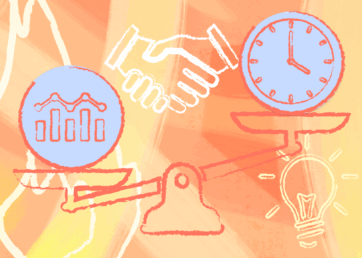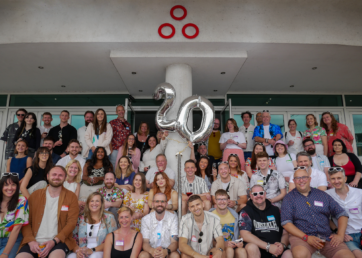The advertising industry doesn’t have the best reputation when it comes to work-life balance. It’s notorious for its fast-paced, high-pressure environment, where tight deadlines and demanding clients are the norm.
“It’s agency life” is the rationale behind the culture. You’ll hear the term echo across the globe, from advertising and marketing agencies, to design and brand studios.
It’s so prevalent that it has its own hashtag, #agencylife, currently boasting 2.6 million posts on Instagram alone.
But does it have to be this way? Is there hope for happier, healthier cultures at agencies?
In this article 📖
Why the advertising industry struggles to achieve work-life balance
Advertising is a demanding industry, there’s no doubt about it. It’s a creative, dynamic, and competitive field that commands constant innovation and adaptability from its employees.
The result is working long hours, late nights, and weekends—none of which contribute to a healthy work-life balance.
But what are the real driving factors behind the culture?
The origin of agency life
Remember the show Mad Men with its slick suits and booze-fueled brainstorming sessions? It was a pretty accurate representation of Madison Avenue in its heyday. Back then, ad execs made scenarios of hard work and high rewards look prestigious—despite the unfavorable schedule.
And 70-something years later, while the suits and cigars have been replaced with coffee and keto bars, the late nights and working lunches are still firmly embedded in today’s agency culture.

Ivan Dmitri/Michael Ochs Archives, via Getty Images
But as the perks have gone from first-class Pan Am tickets to pizza parties, the prestige is fading—and it has been fading for quite some time.
So what’s behind it all? Client needs, of course.
Clients come first
If you don’t have any clients, you don’t have any revenue, and if you don’t have any revenue, you don’t have an agency. It’s simple math.
The problem is that clients have plenty of agencies to choose from, so if you’re not at their beckoning call, they might go looking elsewhere.
Confirming the above, the Marketing Relationship Survey 2022 from SetUp, revealed that almost 40% of brands are thinking about switching agencies in the next six months.
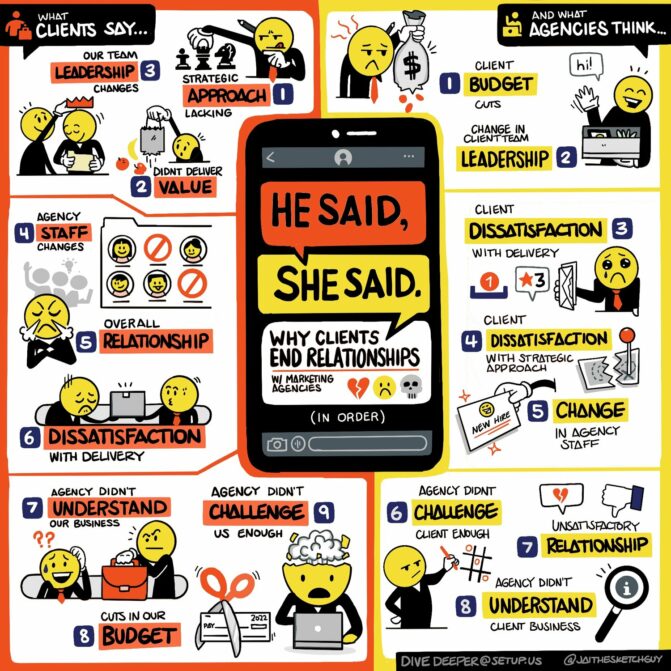
The problem? Misalignment.
As the study showed, agencies don’t seem to be aware of the actual motivation behind clients leaving them, citing budget as the reason. When in reality, leadership changes and lack of strategic approach are the most common causes.
Perhaps the budget is just an excuse? A narrative told to agencies to avoid tough conversations? Truth or not, it doesn’t help either party.
But a study from 4A’s and ANA shows, at least when it comes to the matter of project success, that clients and agencies are mostly in alignment. In their study, they surveyed both agencies’ and clients’ views on different statements.
The statement related to project success read, “Clear criteria for success should be established and communicated to the agency.”
100% of both agencies and clients agreed with this statement.
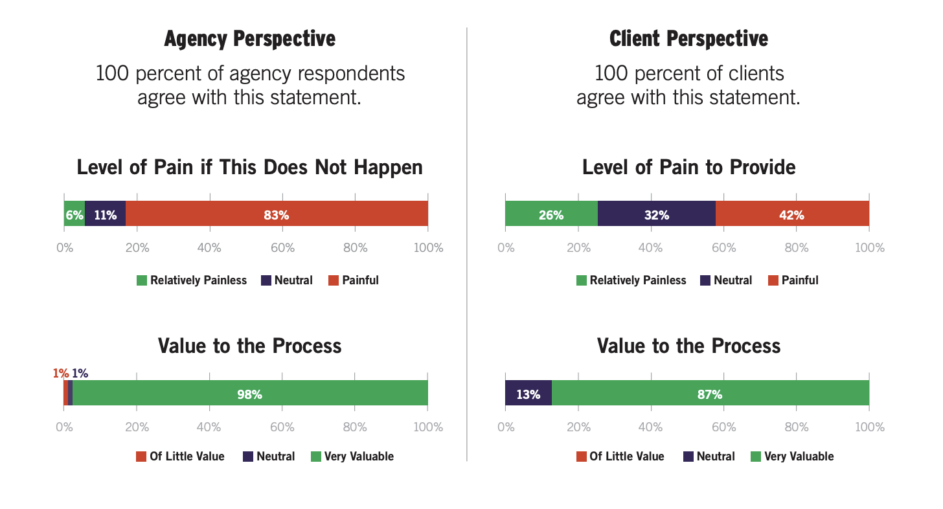
So where do things go wrong? Does the view of success change along the way? Is there a lack of communication? Is the project scope unrealistic? Does something go wrong during project execution? Or do all of the aforementioned (and then some) make clients go looking for more fruitful partnerships?
Amid all this, the well-being of employees is sacrificed in favor of prioritizing the profitability of the business and the satisfaction of clients. But happy clients, don’t necessarily mean happy employees.
Regardless of the cause, the symptom of the problem(s) remains the same: lack of work-life balance for agency employees.
Feeling the burn(out)
In 2019, the World Health Organization (WHO) recognized burnout as an occupational phenomenon. Today, it’s categorized in their International Disease Classification (ICD-11) as a “syndrome” that results from “chronic workplace stress that has not been successfully managed.”
But if you think people fleeing the ad industry is the result of covid and “always-on” culture—think again. The issue goes much further back.
In the golden days of advertising, the life expectancy of ad execs was significantly lower compared to other industries. In 1956, a study by Life Extension Examiners of New York compared the health of executives in manufacturing, banking, and advertising.
The results?
Between the years 1949 and 1959, the life expectancy for white males was 67.1 years. The average age at death in Advertising Age’s obituaries was 59.9, knocking an average of 7.2 years off their lives.
In an interview with NinjaCat, Nick Ellis, Creative Partner and Founder of the UK ad agency, We Are Halo said that “the work itself doesn’t burn people out, it’s the pressure from the agency and clients (and how their expectations are managed) that does the damage. If senior management looked up from the numbers and stopped billing for time like a lawyer—things would get better.”
So can agencies manage to balance employee and client needs? It’s a tough nut to crack.
Read more about agency burnout here.
Balance looks different for everyone
Just like productivity is personal, balance looks different for everyone. What you value and prioritize is up to each individual.
Some people might thrive pulling a 16-hour shift, only to wind down the next day, while others prefer a steady routine. The challenge lies in accommodating different ways of working and scheduling preferences when there are deadlines and revenue at stake. (Giving project managers an even more challenging task when it comes to balancing schedules.)
Adding to the challenges above, advertising also faces pressure from other industries such as tech, with its (sometimes glorified) flexible schedules, and remote and nomadic cultures. This is exactly why people in advertising are leaving the industry behind and opting not only for better work-life balance, but also better pay.
Ultimately, agencies that won’t cater to evolving employee needs will struggle with both attracting and retaining talent.
And right now agencies are in a tough spot. So who’s leading the charge? Gen Z.
Saying goodbye to “the grind”
The driving force behind the work-life balance movement is Gen Z and millennials.
On apps like Reddit and Fishbowl, the sentiment is clear: no one is interested in going above and beyond for a company that could (and would) drop you at any moment.
And these generations are not only noticing the glaring work-life balance deficit, but the results of it: a mental health crisis.
This post on the subreddit r/advertising created a roaring discussion as people in agreement made their voices heard.
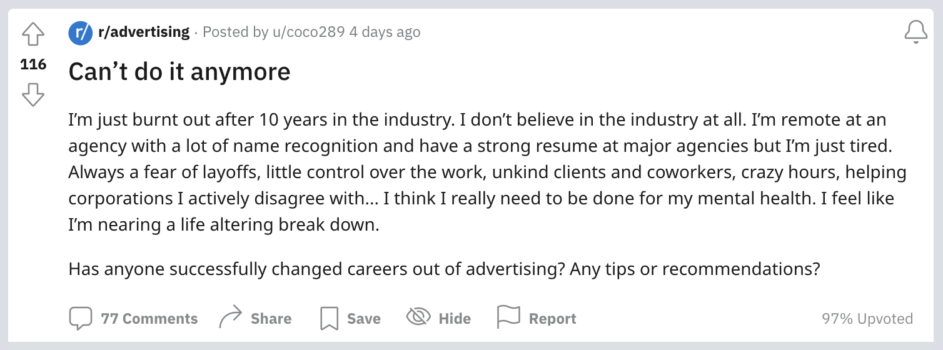
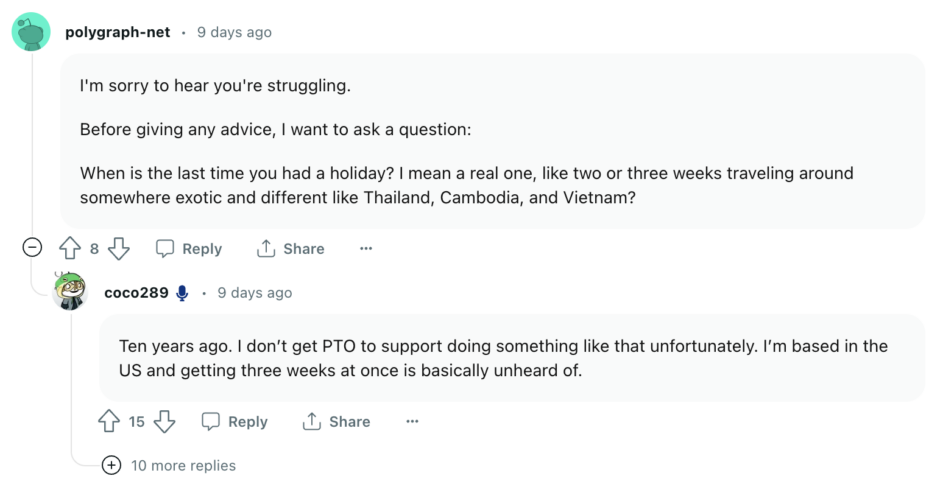
Once again, the message is clear: the advertising industry needs to change.
Could a call to arms from a beer brand push the industry in the right direction?
From overworking to working responsibly
In an unmissable campaign, Publicis and Heineken illuminated the walls of New York City office buildings. In a simple, yet brilliant, effort to encourage people to work responsibly, they projected messages like “overworking?” and “working late?” onto buildings where people were seen burning the midnight oil. After all, where better to launch the campaign than in the city that never sleeps?
While the campaign promotes Heineken’s satirical high-tech bottle opener that shuts down your computer automatically when you crack open a Heineken, the message is an important one.
“Through this campaign, we’re challenging the culture of overworking that continues to get in the way of moments that matter. By projecting our ad onto a building where people were working late into the evening, we hope to encourage people to reprioritize the ‘life’ in ‘work-life balance’”, says Bram Westenbrink, global brand head at Heineken.
Westenbrink continues: “As a brand that is built around the celebration of real moments of human connection, we strongly believe that life is about making time for friends over a beer, and not for late nights in the office alone.”
Plus, if the best ideas happen over dinner and drinks, then why the heck are people still in the office or sat in front of their laptops at home?
While the message is on the nose, it’s hard to ignore the irony of it all. It begs the question, how many late nights did Publicis’s creative team pull to swing this campaign?
Can this industry unlearn its habits?
Unlearning and reshaping
The people in power today still have the mindset of days long gone. But as the advertising industry asks, “where are all the people?” unfortunately, it doesn’t have the luxury of time. They can’t wait for Gen Z and millennials to rise up into leadership positions—change needs to start now.
In an article for Ad Week, Madi Getgood highlights the issue of advertising’s set ways: “the old ways of working no longer work, and we can’t afford to keep pretending they do. Junior associates shouldn’t have to wait until they reach a certain level to start the shift when there are people who have the power to do so now.”
Getgood gives readers some food for thought, challenging Gen Z and millennial stereotypes: “a whole generation is begging for change—let’s not mistake their empowerment for entitlement.”
If advertising is stuck in the past, how can it move toward a better future? While there’s a lot of unlearning to do, why not kick off the conversation with a topic that resonates with everyone?
Money.
Balance is better for the bottom line
If we look at the numbers (and we should), a finding by Gallup shows that highly engaged employees result in 21% increased profitability.
And if work-life balance boosts productivity and increases employee engagement, then why aren’t agencies doing their best to reshape their work cultures to reflect this?
The answer is this: Well-being is not seen as a business strategy.
Naz Beheshti, CEO of Prananaz, agrees. In a Forbes article, she takes a stand when it comes to employee engagement and well-being, saying “they have been viewed as the responsibility of the HR department and not an integral part of business strategy.”
Meanwhile, John Clifton, CEO at Gallup said that “the world is closer to colonizing Mars than it is to fixing the world’s broken workplaces” in their State of the Global Workplace: 2022 Report.
That same survey found that employee well-being is the new workplace imperative, urging organizations to think about the whole person, not just the worker.
Clifton adds, “executives everywhere should want the world’s workers to thrive. And helping the world’s workers thrive starts with listening to them.”
Time to rebrand agency life
It’s time to take employee well-being seriously and make it a part of business strategies rather than an HR checkbox to tick off.
It’s time to turn toxic workplaces run by “talented geniuses” into well-balanced workplaces where well-being comes first.
It’s time to realize that if your employees are well, your business will do well.
And the time to do it—is now.




